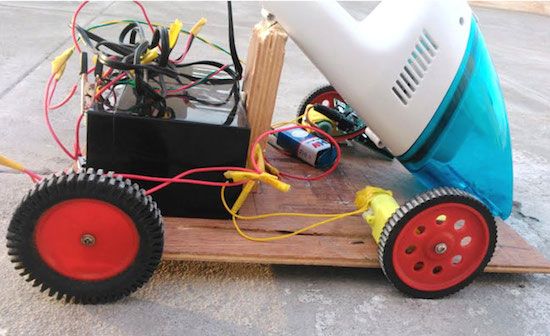![]()
This dust buster-based robotic vacuum may or may not work as well as a Roomba.
If you’re fascinated by the idea of a robotic vaccum cleaner to keep you from having to do certain chores, you could buy an iRobot, or you could make your own instead. This particular DIY model uses four motors for locomotion, an Arduino Uno, an IR and ultrasonic sensors to avoid obstacles, as well as a (formerly) handheld vacuum cleaner to suck up debris.
The assembly sits on a wooden chassis, and as author B. Aswinth Raj is quick to point out, many variations on this robot could be made. Code is included and fairly short, so whether you’d like to copy this design or improve upon it, the bot should certainly give you some build ideas!
In this project we will use the power of embedded systems and electronics to make our own robot which could help us in keeping our home or work place neat and tidy. This robot is simple four wheeled vacuum cleaner which could smartly avoid obstacles and vacuum the floor at the same time. The idea is inspired by the famous vacuum cleaner iRobot Roomba…
You can find more detailed instructions, along with its code and a circuit diagram, on this CircuitDigest page.
This entry was posted by Arduino Team on Friday, September 23rd, 2016 and is filed under Arduino, Featured, Robots, Uno. You can follow any responses to this entry through the RSS 2.0 feed.
You can leave a response, or trackback from your own site.
You must be logged in with your Arduino account to post a comment.
How to control Arduino board using an Android phone
Arduino IDE 1.6 is released! Download it now
DIY less-expensive Thermal imaging camera
Send in the clones
My open-source, do-it-yourself cellphone (built with Arduino).
Welcome Arduino Yún – the first board combining Arduino with Linux
Microsoft and Arduino: new partnership announced today
A low-cost robotic hand (tutorial) mirroring your own fingers
Arduino IR Remote Control
Nice drawings of the Arduino UNO and Mega 2560
David Cuartielles (Spanish)
MAKE: Blog’s Arduino archive
Tom Igoe’s PComp Site

